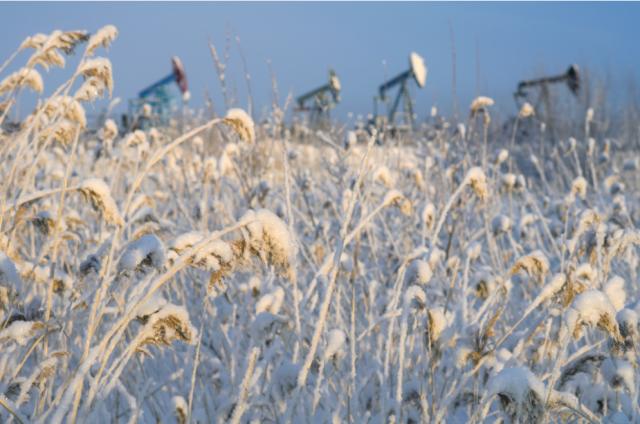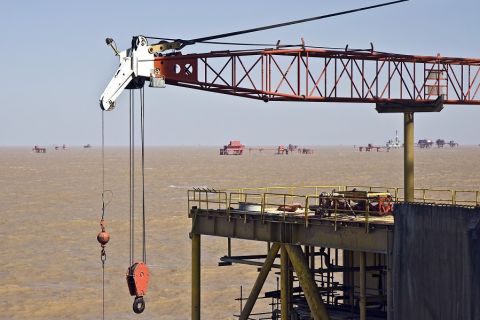
Winter storms in Texas may have reduced overall output for the year by roughly 200,000 to 500,000 bbl/d, depending on the status of older wells and unfinished wells that may not recover. (Source: Shutterstock.com)
Learn more about Hart Energy Conferences
Get our latest conference schedules, updates and insights straight to your inbox.
U.S. crude oil production dropped by more than 1 million bbl/d last week during Texas’ deep freeze, equaling the largest weekly fall ever, and refining use also fell dramatically, the Energy Information Administration (EIA) said on Feb. 24.
Overall output fell by 1.1 million bbl/d to 9.7 million bbl/d in the week to Feb. 19, the EIA said, as the brutal cold forced most of the state’s power grid offline, and oil operators and refiners were forced to shut as components and pipelines froze.
Some analysts had estimated far higher figures for production declines, with some saying shale fields had largely shut down due to the cold. Weekly production figures incorporate heavy estimates, however, and monthly data—which is issued on a lag—is considered more accurate.
Oilfield output is rebounding, however, with Pioneer Natural Resources Co., one of the larger shale operators in Texas and New Mexico’s Permian basin, saying most of its production has returned.
“It’s my understanding as I’ve talked to CEOs and operators that most folks are back online," said Ben Shepperd, president of the Permian Basin Petroleum Association.
The storms, however, may reduce overall output for the year by roughly 200,000 to 500,000 bbl/d, depending on the status of older wells and unfinished wells that may not recover.
“There is some concern that this will be a long-term permanent production drop,” said Phil Flynn, senior analyst at Price Futures in Chicago.
Oil prices rose on the report, and as traders anticipate refining demand to rebound. WTI crude futures in the U.S. gained $1.47, or 2.4%, to $63.12/bbl as of 11:08 a.m. EST (1608 GMT), while Brent rose $1.69, or 2.6%, to $67.08.
Refinery crude runs fell by 2.6 million bbl/d in the week, and refinery utilization rates slumped by 14.5% to 68.6% of capacity on the week, the EIA said, as numerous facilities in the refining hub along the Gulf Coast shut down. Many of those operations, including Motiva Enterprises’ Port Arthur facility, were now restarting.
Crude inventories rose by 1.3 million barrels in the week to 463 million barrels, compared with analysts’ expectations in a Reuters poll for a 5.2 million-barrel drop.
Crude stocks at the Cushing, Okla., delivery hub rose by 2.8 million barrels.
Net U.S. crude imports rose by 249,000 bbl/d, the EIA said, but imports alone dropped by 1.3 million bbl/d to about 4.6 million bbl/d, the lowest since 1992, the data showed.
U.S. gasoline stocks rose by 12,000 barrels to 257.1 million barrels, compared with expectations for a 3.1 million-barrel drop.
Distillate stockpiles, which include diesel and heating oil, fell by 5 million barrels in the week to 152.7 million barrels, versus expectations for a 3.7 million-barrel drop, the EIA data showed.
Recommended Reading
TotalEnergies Starts Production at Akpo West Offshore Nigeria
2024-02-07 - Subsea tieback expected to add 14,000 bbl/d of condensate by mid-year, and up to 4 MMcm/d of gas by 2028.
E&P Highlights: Feb. 5, 2024
2024-02-05 - Here’s a roundup of the latest E&P headlines, including an update on Enauta’s Atlanta Phase 1 project.
CNOOC’s Suizhong 36-1/Luda 5-2 Starts Production Offshore China
2024-02-05 - CNOOC plans 118 development wells in the shallow water project in the Bohai Sea — the largest secondary development and adjustment project offshore China.
US Drillers Cut Oil, Gas Rigs for First Time in Three Weeks
2024-02-02 - Baker Hughes said U.S. oil rigs held steady at 499 this week, while gas rigs fell by two to 117.
Equinor Receives Significant Discovery License from C-NLOPB
2024-02-02 - C-NLOPB estimates recoverable reserves from Equinor’s Cambriol discovery at 340 MMbbl.




